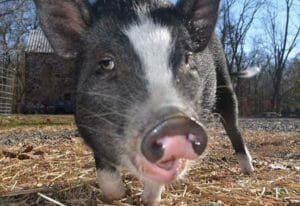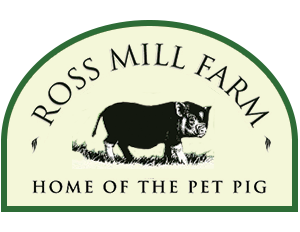
The history of the potbellied pig today can be traced back to Keith Connell’s import to the US from Canada in the mid-eighties. By today’s standards they were relatively large (60 to 80 kg). They were all black and wrinkled, particularly about the head and face. They also had the other characteristics we associate with the “breeder”, usually referred to as the foundation stock. Keith named them the “Con Line”.
However, shortly after the original importation, at least two other “breed types” entered the U.S. These included the Lea Line imported by Leavitt, with a gentle disposition, white and black markings, and being somewhat smaller. It also included the O’Royal Line, imported by Espberger. These pigs were mostly white and somewhat larger than the Lea Line.
These three lines, Con, Lea, and Royal, represent most of the foundation stock found in America today.
The different lines provided a larger gene pool to work with. They gave us a healthier breed type and enabled breeders to develop more desirable characteristics that were better suited for a domesticated companion. They could become house pets.
But why is there such a wide variety of breed types in the first place?. To answer this question, we must first understand the origin of the species.
Origin Stories
The potbellied pig is a direct descendant of the old world wild pig family. Order (Artiodactyla), Suborder (Suins),Family (Suidae), Genus(Sus Scrofa) – the wild boar.
Range
For over 40,000 years they ranged across Eurasia. The pigs moved from the Pacific to the Atlantic coast, and from the Mediterranean to the fringe of Siberia. The variety of habitat combined with the adaptability of this mammal produced a variety of species with many common traits.

Wild Hog
https://www.pexels.com/photo/brown-wild-boar-1344772/
The potbellied pigs of today are generally associated with South East Asia and, in particular, Vietnam. The Vietnamese Potbelly Pig is not technically a breed, but a local type. (Breed: “a group of animals that man selected to possess a uniform appearance that is inheritable and distinguishes it from other groups of animals within same species”.) This means the type of pig that is generally indigenous to an area. The variety we see in America is probably the result of cross-breeding the four local types of Vietnamese pigs. They share many common characteristics like pointed ears, sway back, straight tail, pot belly, size, and gentle disposition. Each type originated in a different part of Vietnam.
Local Types
- North Vietnam – The OiO pig (the shortest breed type name in the world)makes its home in the West near the Red River Delta. It is the type most common in Vietnam and the pig known as the Vietnamese potbellied pig….the original “Con Line”. A larger pig (up to 90Kg) but still very small compared with domestic pigs. It has wrinkled black skin, particularly about the head with a dished face, narrow forehead and small upright ears.
- You can find the OMong CaiO in the Northeast near the Chinese border and Gulf of Tonkin. It is slightly larger than the “I” (100kg) with more hair, white with black head, white snout and black patches elsewhere on the body. It is generally associated with the Lea Line.
- Central Vietnam: The “co” is very small (up to 40kg) pig. Originally wide-spread in central Vietnam, it is now restricted to the high plateau region. With a cubby body type and more of a slope to its back, this breed type has greatly influenced our “American” potbellied pigs.
- South Vietnam: The “Heo Moi”, sometimes called the Vietnamese primitive, originally roamed the mountain area on the South. Also very small (40-45 kg), they’re swaybacked with hanging stomachs and a longer snout. Today, mainly in the rich Mekong delta, they have become larger (60kg) but still possess veracity and many characteristics of their free-range mountain kin. Here too we see many of their traits in our American “breed types”.
What to Look For
When looking for a pet, going to a show, or just enjoying your own pet pig, see if you can spot the unique characteristics of the I, Mong Cai, Co, and Heo Moi breed types. The judges are looking for a blending of many traits. Everyone is looking for healthy, happy pets.
Written by Richard Magidson, Ross Mill Farm Rushland, PA.
Used with permission from Susan Magidson.


